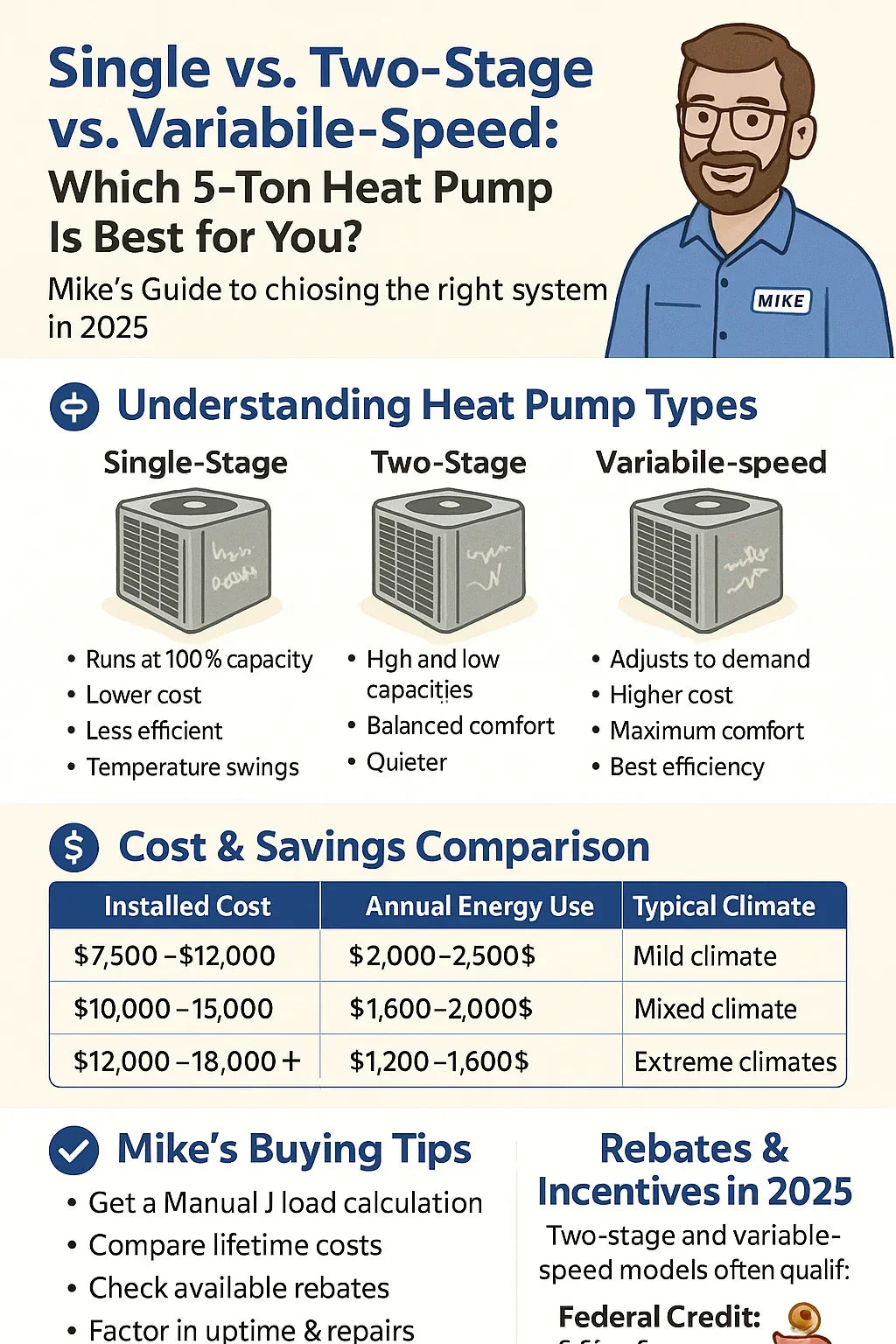Mike’s Guide to Choosing the Right System in 2025
🏠 Introduction: Why Staging Matters for Comfort & Efficiency
If you’re shopping for a 5‑ton heat pump in 2025, you’re already thinking big. At about 60,000 BTUs, this system is designed for homes between 2,400 and 3,000 sq ft in moderate climates—or slightly smaller homes in northern states. But here’s the twist: not all 5‑ton heat pumps are built the same.
The choice between single-stage, two-stage, and variable-speed models could mean the difference between paying high utility bills and enjoying year‑round comfort at a lower cost. As a homeowner myself, I’ve seen the impact firsthand. In this guide, I’ll walk you through what each option offers, how much they cost, and which one might be best for your home.
⚙️ Understanding Heat Pump Staging
🔹 Single‑Stage Systems: The Budget-Friendly Workhorse
-
How it works: Runs at 100% capacity until the thermostat says “stop.”
-
Pros:
-
Lowest upfront cost.
-
Simple design = fewer repair points.
-
Works well in mild climates.
-
-
Cons:
-
Less efficient, especially during mild weather.
-
Temperature swings noticeable (room feels warm, then cools again).
-
Can short-cycle in larger, well-insulated homes.
-
👉 Learn more: Carrier Heat Pump Basics
🔸 Two‑Stage Systems: Balanced Comfort & Efficiency
-
How it works: Operates on low stage (~70%) most of the time; kicks into high stage (100%) during peak demand.
-
Pros:
-
Better humidity control.
-
Fewer temperature swings.
-
Quieter than single-stage.
-
~15–20% more efficient.
-
-
Cons:
-
Higher upfront cost than single-stage.
-
Slightly more complex (more parts = potential repair cost).
-
👉 Reference: Energy.gov Heat Pump Efficiency
⚡ Variable‑Speed (Inverter) Systems: The Gold Standard
-
How it works: Adjusts compressor speed in tiny increments, like a dimmer switch for your HVAC.
-
Pros:
-
SEER2 ratings often 18–22+ for top efficiency.
-
Best humidity control.
-
Extremely quiet operation.
-
Matches capacity to demand perfectly.
-
Longest lifespan due to reduced strain.
-
-
Cons:
-
Highest upfront cost.
-
Advanced electronics = higher repair bills if problems occur.
-
👉 Learn about inverter technology: Mitsubishi Electric HVAC
💰 Upfront Cost Comparison (2025 Estimates)
| Type | Typical SEER2 Range | Installed Cost (2025) |
|---|---|---|
| Single‑Stage | 14–15 | $7,500 – $12,000 |
| Two‑Stage | 15–17 | $10,000 – $15,000 |
| Variable‑Speed | 18–22+ | $12,000 – $18,000+ |
These numbers include both equipment and professional installation. Remember: location, ductwork, and electrical upgrades can swing these figures.
👉 Pricing reference: HVAC Laboratory 2025 Cost Guide
🔋 Efficiency & Operating Costs
📊 Annual Energy Use
-
Single‑Stage: $2,000–$2,500/year in average climates
-
Two‑Stage: $1,600–$2,000/year
-
Variable‑Speed: $1,200–$1,600/year
At 15–17¢ per kWh in 2025, the savings add up fast.
👉 Efficiency metrics explained: ENERGY STAR Heat Pump Ratings
🌡️ Comfort & Climate Suitability
-
Single‑Stage: Fine for southern or coastal climates where winters are mild.
-
Two‑Stage: Best for transitional climates (Virginia, North Carolina, Midwest).
-
Variable‑Speed: Essential for northern or extreme climates (Minnesota, New England), especially for homes above 2,800 sq ft.
👉 Regional climate guide: Quality Home Air Care
🧾 Maintenance & Reliability
🔧 What to Expect Over Time
-
Single‑Stage:
-
Cheapest to repair, ~$200–$500 typical service.
-
Lifespan ~12–15 years.
-
-
Two‑Stage:
-
Slightly higher repair cost, ~$300–$700.
-
Lifespan ~15 years with good maintenance.
-
-
Variable‑Speed:
-
Advanced repairs: $500–$1,200 if electronics fail.
-
Lifespan ~15–20 years thanks to smoother operation.
-
👉 Maintenance advice: The Furnace Outlet – Heat Pump Care
🏦 Rebates & Incentives (2025)
🌱 Federal Tax Credits
-
30% of project cost, up to $2,000
-
Requires ENERGY STAR Most Efficient models (often two-stage or variable-speed).
-
Available through December 31, 2025.
👉 Full details: ENERGY STAR – Federal Tax Credits
⚡ State & Utility Rebates
-
Some utilities offer $1,000–$2,500 per system for qualifying models.
-
Example: A variable-speed 5‑ton system could get $4,000+ back combining state + federal rebates.
👉 Rebate updates: The Furnace Outlet – 2025 Rebates
📊 Mike’s Recommendation Scenarios
🏠 Scenario 1: Budget-Conscious in Texas
-
Equipment: Single‑Stage SEER2 15
-
Installed Cost: ~$9,000
-
Net after federal rebate: ~$7,500
-
Works well because winters are mild.
🏡 Scenario 2: Family in Virginia
-
Equipment: Two‑Stage SEER2 16
-
Installed Cost: ~$13,000
-
Net after rebates: ~$10,000
-
Balances comfort and cost for hot summers + chilly winters.
❄️ Scenario 3: Cold Climate in Minnesota
-
Equipment: Variable-Speed SEER2 20+
-
Installed Cost: ~$15,000
-
Net after rebates: ~$11,500
-
Needed for reliable heating and efficiency in sub‑zero winters.
🪜 Mike’s Buying Checklist
-
✅ Get a Manual J load calculation—don’t size by square footage alone.
-
✅ Check SEER2 and HSPF2 ratings for rebate eligibility.
-
✅ Compare three quotes—ask about hidden costs (ductwork, permits).
-
✅ Consider lifetime costs—higher efficiency = lower bills.
-
✅ Ask about humidity control—especially if you live in humid regions.
-
✅ Plan for maintenance—budget ~$250/year for service.
👉 More rebate info: Klimatology HVAC IRA Guide
✅ Conclusion: Picking the Right Fit for Your Home
Choosing between single‑stage, two‑stage, and variable‑speed isn’t just about price—it’s about matching your home’s climate, size, and comfort needs.
-
Go single‑stage if you’re in a mild climate and need a budget-friendly system.
-
Choose two‑stage if you want a balance of comfort and cost.
-
Invest in variable‑speed if you demand maximum comfort, efficiency, and rebates.
Bottom line from me: Don’t just buy the biggest 5‑ton unit—buy the right technology for your home’s needs.
⚡ Mike’s advice: Before you commit, let’s run the numbers together. A Manual J calculation and a rebate check could save you thousands.
In the next topic we will know more about: How Efficient Are Today’s 5-Ton Heat Pumps? Understanding SEER2, HSPF2 & Energy Ratings







